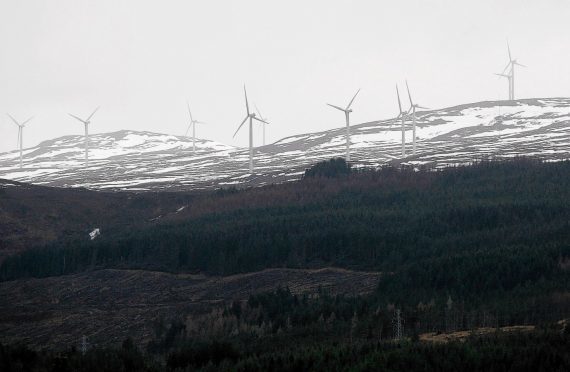Campaigners have reacted with fury at a Scottish Government decision to approve plans for a windfarm extension near Loch Ness.
Developers Falck Renewables will build 10 more towers – standing 430ft high – beside their 26-turbine Millennium near Fort Augustus.
The scheme at Glenmoriston, five miles west of the village, will power 20,000 homes and was approved following a three-day public inquiry held in March last year.
But objectors have voiced fresh concerns about the impact on visual amenity – adding to a so-called ‘ring of steel’ around the loch – and questioned the economic sense for the extension.
Anti-windfarm campaigner Stuart Young said the latest figures from the Renewable Energy Foundation website show that, since 2011, Falck Renewables received £11.08million in “constraint payments” to the national grid to switch off turbines and not produce electricity.
The constraint payment is money paid to energy companies to stop feeding power to the National Grid in order to balance supply with demand.
Mr Young said that the wind generation is more expensive than oil and gas because not only do constrained off wind generators lose the sale of electricity, but they lose their renewables subsidy, making it more costly to be compensated by the national grid for their loss.
Mr Young said: “This Scottish Government is intent on covering this country with windfarms which are just not needed.
“It’s absolute lunacy constructing windfarms that are not required and to pay more for them not to generate electricity than they would earn while generating. This money goes on to people’s electricity bills, and it goes on to the baker’s electricity bill and it will be added on to the price of a loaf of bread.”
Mr Young also made reference to the visual impact of this latest scheme to be approved near Loch Ness.
He said: “Most of these developments around Loch Ness still have to be constructed. It’s certainly the case here that you won’t be able to move very far without sight of a windfarm and it will be a different one each time. You won’t be able to escape them. They are sprinkled all over the place.”
Following yesterday’s decision, Paul Wheelhouse, minister for Business, Innovation and Energy, said the project will create 40 to 50 full time equivalent jobs during construction and generate up to £4million in community benefit, split equally between local communities.
But Mr Young claimed that the promises of community benefit are “misleading” because many of the people directly affected by windfarms lose out if they want to sell their house.
He added: “Developers should compensate the people who suffer most and if they have any money left then spend it on supporting organisations in surrounding communities. The Scottish Government is complicit in this.”
Council leader Margaret Davidson, also an Aird and Loch Ness councillor, said this was the third time the scheme had been extended and that the community were against the most recent extension.
She added: “It’s right next to another windfarm, Beinneun, and it all covers a huge area. It’s a cumulative effect issue. And these new turbines are bigger than the ones that are already there.
“The Scottish Government should not be overturning a local decision lightly. They say it’s on policy grounds, but over provision in an area and impact on landscape results in our interpretation being that this is a step too far.
Campaigner Lyndsey Ward said: “It’s absolutely ludicrous that they are going ahead with these developments without the grid capacity for them.”
In yesterday’s statement, minister Paul Wheelhouse added: “Renewable energy sources generated a record 56.7% of gross electricity consumption in Scotland in 2015, helping support our world-leading ambitions to become a low-carbon economy.”
Toni Volpe, CEO of Falck Renewables, said the decision reflects the Scottish Government’s commitment to realising Scotland’s potential as a centre for clean and green energy.
He added: “This wind farm extension will also support local community projects, help Scotland meet its energy targets and include measures to protect breeding birds and the environment.
“As the Scottish Government suggested in its recent onshore wind policy statement, we will continue to work to develop innovative schemes to create new community benefit packages that reflect evolving business models and support local people.”
